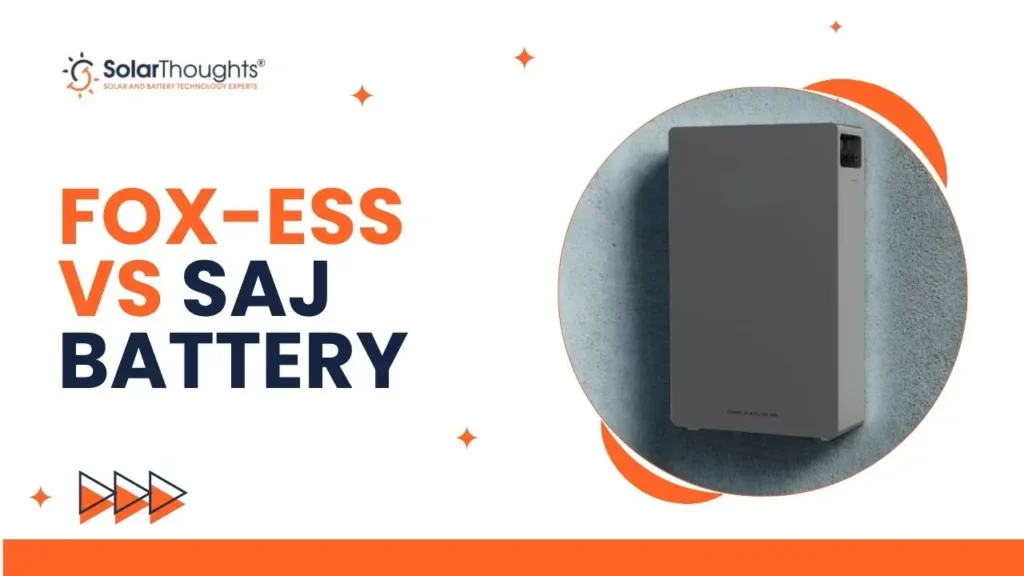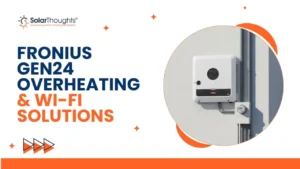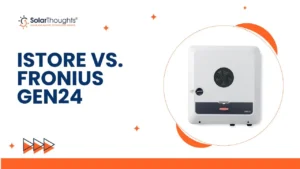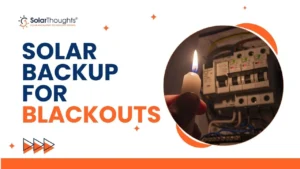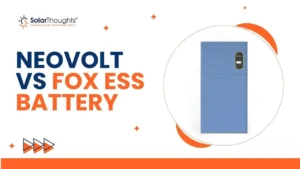Could your battery choice save you thousands—or cost you more in the long run? With Australian electricity prices reaching record highs in 2025, selecting the right solar battery can have a direct impact on your wallet and energy independence.
Table of Contents
ToggleAt SolarThoughts®, we know choosing between batteries feels overwhelming. SAJ has built its reputation on budget-friendly pricing and reliable performance. Fox-ESS counters with technical power—their EQ4800 series offers 90% Depth of Discharge, expandability up to 41.94kWh, and a robust ≥6000 cycle lifespan.
Which suits your home better? SAJ’s cost-effective simplicity or Fox-ESS’s performance-focused modularity? Our comparison reveals what actually matters for your energy needs and budget.
Brand Overview: Fox-ESS vs SAJ Battery
Understanding the companies behind these battery systems helps you make a more informed choice for your home. SAJ has been developing solar technology since 2005, building their expertise in inverters, motor drives, and energy storage before establishing their Australian operations in 2019. Fox-ESS took a different path, launching in September 2019 and shipping their first international orders by April 2020.
Company Background and Market Presence
Fox-ESS has grown rapidly with backing from the Fortune 500 Tsingshan Group, expanding across global markets quickly. The company reached unicorn status on the Forbes Global Unicorn List by May 2023, with a valuation over 10 billion. They entered the Australian market in 2021 with solar inverters, adding battery systems in 2022.
SAJ has built their reputation on affordable, dependable technology. While their market position details are less public, their Australian growth comes from cost-effective solutions that work well for homeowners watching their budgets.
Popular Models in Australia: EQ4800 vs A1 Series
The Fox-ESS EQ4800 serves as their main battery solution for Australian homes. Each module delivers 4.66 kWh of capacity, and you can stack up to nine modules for a total of 41.94kWh. Fox also offers the EP11, a compact 10.36kWh wall-mounted option.
SAJ focuses on their A1 Battery Modules as part of their budget-friendly home storage range. These batteries work smoothly with SAJ’s H2 Series Hybrid Inverters.
Battery Chemistry: LiFePO4 in Both Systems
Both manufacturers choose Lithium Iron Phosphate (LiFePO4) chemistry for their batteries. This technology brings several benefits compared to other lithium options. Fox-ESS highlights how LiFePO4 provides excellent thermal stability, lower fire risk, and environmental advantages since it contains no cobalt.
This chemistry also supports longer battery life—Fox-ESS batteries deliver 6,000+ cycles at 90% Depth of Discharge, potentially running for over 16 years with daily use. Both systems offer solid durability protection, with Fox-ESS providing a 12-year warranty and SAJ backing their batteries with 10 years.
Performance and Efficiency Metrics
Real-world performance separates quality battery systems from basic storage options. These key specifications show how Fox-ESS and SAJ batteries perform when powering your home daily.
Round-Trip Efficiency: 95% vs 92%
Fox-ESS batteries deliver superior round-trip efficiency of ≥95%, minimizing energy waste during charge and discharge cycles. SAJ batteries achieve approximately 90-92% efficiency. This 3-5% difference means Fox-ESS systems convert more of your solar energy into usable power, potentially boosting your savings over time.
Depth of Discharge: 90% vs 80%
The Fox-ESS EQ4800 series provides 90% Depth of Discharge (DoD)[102], letting you access most stored energy without compromising battery health. SAJ batteries typically offer DoD ratings between 80-90%[112], with newer models reaching the higher end. Fox-ESS systems therefore deliver more usable energy per kWh of rated capacity.
Discharge Rate and Power Output
Continuous discharge currents up to 27A give Fox-ESS batteries steady power delivery during peak demand periods. The EQ4800’s high-voltage design reduces energy loss through better power management. SAJ batteries provide moderate discharge rates that handle standard household needs well but may struggle with multiple high-draw applications running simultaneously.
Temperature Tolerance and Climate Suitability
Fox-ESS batteries function across wide temperature ranges—from -10°C to 55°C for discharging and 0°C to 55°C for charging. This robust temperature tolerance suits Australia’s diverse climate conditions particularly well. Both systems feature IP65 weather-resistant ratings, enabling indoor or outdoor installation across Australia’s varied climate zones.
Design, Modularity, and Installation
Physical design and installation requirements can make or break your battery investment. These practical considerations often matter just as much as performance numbers when you’re living with your system day-to-day.
Modular Stackability: 41.9kWh vs 25kWh
Fox-ESS EQ4800 offers remarkable scalability, allowing expansion from 4.66kWh per module up to an impressive 41.94kWh by connecting nine modules (one Master and eight Slave units). SAJ’s B2 series scales from 5.12kWh to a maximum of 25kWh, providing fewer options for homes with larger energy requirements. This difference matters if you plan to add electric vehicles or expand your home’s energy needs over time.
Inverter Compatibility: Fox Hybrid vs SAJ Hybrid
Both systems require compatible hybrid inverters from their respective manufacturers. Fox-ESS batteries work exclusively with Fox ESS hybrid and AC-coupled inverters, including single-phase and three-phase options. SAJ B2 batteries are compatible only with SAJ hybrid inverters. This means your battery choice also determines your inverter selection—something worth considering if you already have specific inverter preferences.
Installation Complexity: Plug-and-Play vs Manual Wiring
Fox-ESS delivers a true plug-and-play design that simplifies installation, potentially reducing both labor costs and installation time. Their installer-friendly approach includes straightforward modular stacking and CAN communication protocols. Both systems feature IP65 weather-resistant enclosures, giving you flexibility for indoor or outdoor placement. Simpler installation often translates to lower upfront costs and fewer potential issues down the road.
AC vs DC Coupling Options
Both manufacturers focus on DC-coupled solutions, which deliver higher efficiency (96-99% vs 90-92% for AC coupling). DC coupling also allows charging batteries directly from solar panels during grid outages, making it particularly valuable for areas prone to blackouts. This technical advantage becomes a practical benefit when you need backup power most.
Smart Features, Warranty, and Value
The digital capabilities and financial aspects of these battery systems matter just as much as their technical performance when you’re planning a long-term energy investment.
Monitoring Platforms: Fox ESS App vs SAJ App
SAJ delivers a solid energy management experience with real-time monitoring of energy production, consumption, and battery performance through their mobile app. Fox ESS provides basic app functionality, though some users find the interface less intuitive, which can impact the overall experience.
Warranty Terms: 12 Years vs 10 Years
Fox ESS backs their batteries with a 10-year warranty, guaranteeing 70% minimum capacity at warranty end and impressive throughput of 4.1-4.7 MWh per usable kWh. SAJ matches with a 10-year warranty and 70% capacity retention, but offers lower throughput at 3.06 MWh per usable kWh.
User Ratings and Reviews in Australia
Customer feedback tells an interesting story. SAJ batteries earn an outstanding 4.8/5 average rating from 8 reviews, while Fox ESS receives a more modest 3.38/5 from 8 reviews. This gap suggests SAJ may deliver better real-world satisfaction despite Fox ESS’s superior technical specifications.
Cost per Usable kWh: $889 vs $950
Fox ESS batteries cost approximately $889 per usable kWh, making them notably more affordable than SAJ’s $950 per usable kWh. This price difference can add up to meaningful savings, especially for larger battery installations.
Virtual Power Plant (VPP) Participation
Fox ESS recently joined Evergen’s VPP platform, enabling behind-the-meter optimization and participation in wholesale energy markets. Both systems now support VPP participation, creating potential additional revenue opportunities through grid services.
Quick Reference Guide
At SolarThoughts®, we believe in making complex information simple and accessible. Here’s a side-by-side comparison of the key specifications and features that matter most for your battery selection:
This comparison highlights the key differences that will impact your daily experience with each system. We’re here to help you understand what these specifications mean for your specific energy needs and budget.
| Feature | Fox-ESS | SAJ Battery |
| Technical Specifications | ||
| Round-Trip Efficiency | ≥95% | 90-92% |
| Depth of Discharge (DoD) | 90% | 80-90% |
| Battery Chemistry | LiFePO4 | LiFePO4 |
| Maximum Capacity | 41.94kWh | 25kWh |
| Operating Temperature Range | -10°C to 55°C (discharge)0°C to 55°C (charge) | – |
| Weather Protection Rating | IP65 | IP65 |
| Warranty & Lifespan | ||
| Warranty Period | 12 years | 10 years |
| Cycle Life | ≥6000 cycles | – |
| End-of-Warranty Capacity | 70% | 70% |
| Throughput Guarantee | 4.1-4.7 MWh per usable kWh | 3.06 MWh per usable kWh |
| Cost & Value | ||
| Cost per Usable kWh | $889 | $950 |
| Customer Rating | 3.38/5 (8 reviews) | 4.8/5 (8 reviews) |
| Company Information | ||
| Market Entry | 2019 | 2005 |
| Australian Market Entry | 2021 | 2019 |
| Features | ||
| VPP Compatibility | Yes (Evergen platform) | Yes |
| Inverter Compatibility | Fox ESS hybrid and AC-coupled inverters only | SAJ hybrid inverters only |
| Installation Type | Plug-and-play design | Manual wiring |
| Monitoring System | Mobile app (reported less intuitive) | Integrated energy management system with mobile app |
Conclusion
Your choice between Fox-ESS and SAJ depends on your priorities. Fox-ESS offers superior technical specs—95% efficiency, up to 41.94kWh scalability, and better value at $889/kWh—making it ideal for performance-focused homeowners with growing energy needs.
SAJ counters with proven reliability and exceptional customer satisfaction (4.8/5 vs 3.38/5), plus a longer market track record since 2005. If hassle-free operation matters more than peak specifications, SAJ delivers peace of mind.
Both systems provide LiFePO4 safety, IP65 weather protection, and VPP capability—solid foundations for Australian homes.
At SolarThoughts®, we believe either choice advances your energy independence. Pick Fox-ESS for maximum performance and scalability, or SAJ for proven reliability and customer satisfaction. Let’s power your energy independence, one smart choice at a time.
Ready to power your Brisbane home with solar battery storage? Contact SolarThoughts® today for expert guidance tailored to your energy needs and budget.
Disclaimer:
All pricing and data in this blog are collected from online sources and may vary. Please verify details before making any decisions.
Our Popular Services
Top-rated solar panels company in Brisbane | Solar Panel Installation in Gold Coast | Upgrading existing Solar system | Solar Panel Repairs and Maintenance | Solar Panel Cleaning Service | Solar Battery Installations | Solar Inverter Installations

